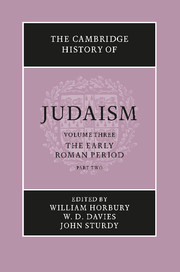Book contents
- Frontmatter
- 1 The archaeology of Palestine 63 bce–ce 70
- 2 The Herodian Temple
- 3 Recent archaeology in Palestine: achievements and future goals
- 4 The contribution of Jewish inscriptions to the study of Judaism
- 5 The social, economic and political history of Palestine 63 bce–ce 70
- 6 The Diaspora in the Roman period before ce 70
- 7 The Gentiles in Judaism 125 bce–ce 66
- 8 Gentiles as seen by Jews after ce 70
- 9 The synagogue
- 10 The Temple and the synagogue
- 11 The early liturgy of the synagogue
- 12 Women in the synagogue
- 13 The Pharisees
- 14 The Sadducees – their history and doctrines
- 15 The Essenes
- 16 The baptist sects
- 17 The troublemakers
- 18 The Samaritans and their sects
- 19 Galilean Judaism and Judaean Judaism
- 20 Jesus: from the Jewish point of view
- 21 Paul: from the Jewish point of view
- 22 Jewish Christianity
- 23 Apocalyptic: the disclosure of heavenly knowledge
- 24 The Qumran sectarian writings
- 25 The Dead Sea Scrolls and pre-Tannaitic Judaism
- 26 Prayer in the Qumran Texts
- 27 Philo of Alexandria
- 28 Josephus (ce 37–c. 100)
- 29 The rabbi in second-century Jewish society
- 30 The Hellenistic–Roman Diaspora ce 70–ce 235: the archaeological evidence
- 31 The legacy of Egypt in Judaism
- 32 Jewish elements in gnosticism and magic c.ce 70–c.ce 270
- Bibliographies
- Index
- References
29 - The rabbi in second-century Jewish society
Published online by Cambridge University Press: 28 March 2008
- Frontmatter
- 1 The archaeology of Palestine 63 bce–ce 70
- 2 The Herodian Temple
- 3 Recent archaeology in Palestine: achievements and future goals
- 4 The contribution of Jewish inscriptions to the study of Judaism
- 5 The social, economic and political history of Palestine 63 bce–ce 70
- 6 The Diaspora in the Roman period before ce 70
- 7 The Gentiles in Judaism 125 bce–ce 66
- 8 Gentiles as seen by Jews after ce 70
- 9 The synagogue
- 10 The Temple and the synagogue
- 11 The early liturgy of the synagogue
- 12 Women in the synagogue
- 13 The Pharisees
- 14 The Sadducees – their history and doctrines
- 15 The Essenes
- 16 The baptist sects
- 17 The troublemakers
- 18 The Samaritans and their sects
- 19 Galilean Judaism and Judaean Judaism
- 20 Jesus: from the Jewish point of view
- 21 Paul: from the Jewish point of view
- 22 Jewish Christianity
- 23 Apocalyptic: the disclosure of heavenly knowledge
- 24 The Qumran sectarian writings
- 25 The Dead Sea Scrolls and pre-Tannaitic Judaism
- 26 Prayer in the Qumran Texts
- 27 Philo of Alexandria
- 28 Josephus (ce 37–c. 100)
- 29 The rabbi in second-century Jewish society
- 30 The Hellenistic–Roman Diaspora ce 70–ce 235: the archaeological evidence
- 31 The legacy of Egypt in Judaism
- 32 Jewish elements in gnosticism and magic c.ce 70–c.ce 270
- Bibliographies
- Index
- References
Summary
Who were the rabbis of second-century Palestine (the ‘tannaitic’ period)? What was their role in Jewish society? What was their relationship with their fellow Jews? In what areas did they exercise authority? What were the institutional bases of their power? In sum, what was the nature of the society in which the rabbis lived and worked? These are the primary questions to be addressed by this chapter.
I admit at the outset that these questions are not fully answerable, and that the answers, whether full or partial, do not yield a complete portrait of the social history of second-century Palestine. A thorough study of Palestinian society would have to treat all the elements of the population: Jews of all sorts (not just rabbis and not just those Jews who came into contact with rabbis), pagans (of all sorts), Christians (of all sorts), and Samaritans (of all sorts). Some of the inhabitants were rich, most were poor; some lived in cities, most lived in towns and villages; some were artisans and traders, most were farmers. The land was as diverse as its population and was divided into politico-geographical regions (Galilee, Samaria, Judaea, Idumaea, the coastal plain, the trans-Jordan, etc.) and sub-regions (notably upper Galilee and lower Galilee). The power structure which governed this complex land was also complex. In addition to the central Roman administration, both civil and military, many cities (poleis) had jurisdiction over substantial amounts of terrain. Other areas (toparchies) were governed from the towns and villages. Each religious group, whether or not recognized by the Roman state, had its own functionaries and temples.
- Type
- Chapter
- Information
- The Cambridge History of Judaism , pp. 922 - 990Publisher: Cambridge University PressPrint publication year: 1999
References
- 6
- Cited by



